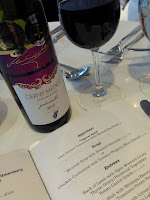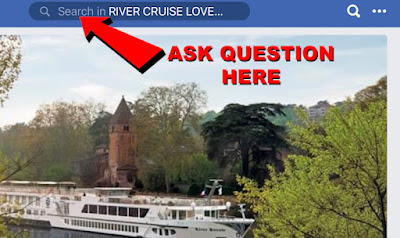Travel and Leisure
I belong to a FB group for river cruising, as it's a fun way to get excited about upcoming trips, and share ideas and knowledge to others who are interested in this unique way of exploring Europe. But it would seem that many folks don't realise that you can use the search feature to find the answer to their questions, and so a number of common questions keep popping up on there. Here are the top three that seem to come up, over and over again, with my thoughts on each.
What do I wear for dinner?
 |
| Dining at the Captain's table on Uniworld |
 |
| River cruising has fine dining; why not dress up a little for it? |
Do I need a travel adapter/converter?
Disclaimer: While I am/was an electrical engineer, please do your own due diligence with respect to using electrical devices in Europe. Since power technology evolved differently in other parts of the world, instead of the 120 volt/60 hertz that we use in North America, Europe uses a 230 volt/50 hertz system, and unfortunately, a few different outlet styles. Luckily for most of us, the only thing that we need power for, is to recharge the batteries in our iPads, smartphones and other portable devices. These are typically powered or charged by a USB Type-A port, with an output of 5 Vdc drawing from 5 to 18 watts. The power supply that you already own performs the conversion from AC to DC is typically rated for 110-240V, 50-60Hz, so it is going to handle the power conversion for you. The only thing that you need to be concerned about, is adapting the two flat prongs to the two round pins used in most of Europe. Now some of you may have NA-spec, 120V/60Hz sockets on your ship, but that's not going to help you when you are at hotels before or after your cruise.Since the Swiss socket (Type C) is like a flattened hexagon, getting adapters that will fit those will be the most versatile, as it will also fit into the round socket (Type F) in other EU countries; these are usually available 2 for $6 on Amazon. Note that you can get them for even less, as I did, but on my super cheap ones, the slots for the NA prongs are the same size, and some plugs have one prong that is slightly larger than the other; these might require a tiny bit of modification with a utility knife to make the slot slightly wider (I chose to file down the wider blade on her travel iron's plug instead). But what if you have other electrical devices that do not have their own power conversion? That's where you will need a power converter. Note that these all-in-one converters from Amazon for $16-25 usually DO NOT convert voltage, and certainly are not be rated for high wattage devices like hair dryers and straightening/curling irons! For those, you need to look for converters that are rated for 2000 watts or more; I had one for my wife's straightener, but it was so hit and miss for some reason, and so she ended up getting a dual voltage one instead, avoiding the problems with trying to convert the power altogether. Update: I wrote a little bit more detailed piece on adapters here.
While the almighty US dollar is the benchmark against which all other currencies are measured, places that don’t take credit card DO NOT want your American dollars. Imagine that you are running a hot dog stand in the US, and some tourist offers you euros? Anyhow, it used to be that you pretty much needed to have some running-around money, as some small restaurants, shops and street markets would only take cash. But with the pandemic, contactless payment options became the norm, and almost anywhere you go, you will be able to use your credit card (take note of your provider's foreign transaction fees; we use the Home Trust Visa for Europe). Regardless, I like to have some local currency on me, as there are a few things that you do need cash for. One is the public toilets; unless you use your cash to buy something small, you won't have any coins to use the facilities. And don't forget that not everyone uses the euro; even though they may be part of the EU Schengen zone, they might still have their own currency. e.g. Hungary uses the forint, the Czech Republic has the koruna, etc. Sure, some folks might accept euros, or even US dollars, but they will not give you a very good exchange rate.
Do I need/where should I get euros/foreign currency
 |
| We needed cash at the Lorenzo Street Market |
While there are those that would swear that they are getting the best exchange rate at the Forex kiosks in the airport, I'd tend to disagree, as I can usually get the best value at my home bank, and typically can even do a little bit of bargaining with the teller. Of course, you can/should be able to get cash from the ATMs that are everywhere in Europe, but make sure you are going to a trusted financial institution, and not some dodgy location inside a pub or at the entrance to the casino; these will give you a terrible exchange rate as well as slap you with a high transaction fee! And when the machine asks you if you want them to do the exchange for you, always decline that, as your home bank will give you a better conversion; the same goes for using your credit card in a retail store or restaurant. How much cash you need is subjective; we don't do a lot of shopping, so would probably only bring the equivalent of $300 USD for a 2-week trip, and then top up at an ATM if we needed more. We did run into one situation in Portugal however, where every cash machine we went to would not give us euros!
Enjoying reading posts about river cruising? Click here for more!





